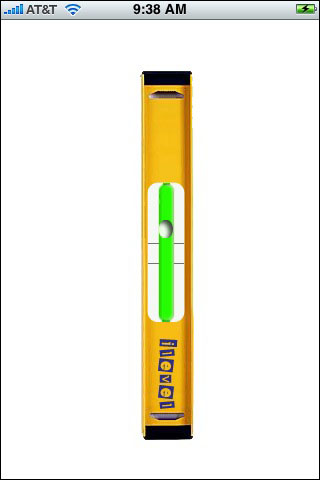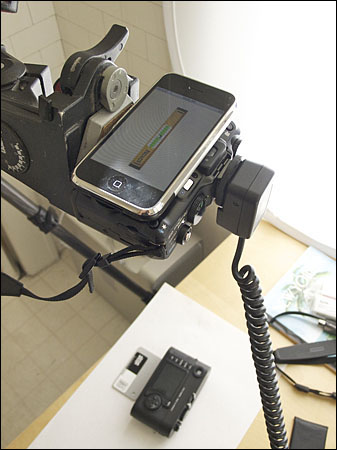The iPhone As Photo Accessory

This article is reprinted with permission of the
Complete Digital Photography Web site.
While the iPhone has a built-in camera — and one that’s surprisingly good for a cell phone — you might find that its real photo value lies elsewhere. I recently needed to shoot product shots of a camera. I decided to use the Canon PowerShot G9 because 1) it’s a very good camera, and 2) its big LCD viewfinder makes the camera easy to use when mounted on a tripod. However, after taking a few shots and moving them to the computer, I discovered my setup had some problems. That’s where the iPhone came in.
You can see my shooting configuration below. The G9 was tripod-mounted, and facing down. The Leica M8 that I was shooting was face-down on a piece of white paper. My main light source was a window with a big diffuser in front of it, and I was using a tethered Canon 580 EX flash unit with a Gary Fong LightSphere to fill in and accent the other side of the camera. Because I don’t have a remote control for the G9, I was using the camera’s self-timer to fire the camera. This allowed me to reduce camera shake. With a product shot, you want all of the details of the subject in focus, so I set the camera to aperture priority, and chose a small aperture to increase depth of field (although, with the G9’s small sensor size, the depth of field isn’t especially shallow in a shot like this, anyway).
Figure 1. My set-up.

I fired off a few shots and took them to the computer to check them out. Once there, I discovered that the camera wasn’t level on its panning axis. Not being a DIY-oriented person, I don’t own a level, though there is a hardware store that’s about a three-block walk away. That hardly seemed worth the trouble, so I figured I’d opt for trial and error.
That’s when I remembered that I had a Jailbroken (read: “hacked”) iPhone in my pocket. With a jailbroken iPhone, you can add third-party custom applications (as well as skins and other new features) to the iPhone using a very simple interface. (Note that, at the time of this writing, there is not yet official third-party support from Apple, so jailbroken phones running Installer.app are still the only options for getting access to third-party functionality.)
I fired up my iPhone and activated iLevel, a small program that turns your phone into an actual, functional level! As you may know, you can rotate the iPhone to view Web pages or photos in a landscape orientation, and then rotate it again to switch back to portrait. All of this rotation is possible because of the iPhone’s built-in accelerometers. iLevel simply takes advantage of those accelerometers to turn your phone into a working level.
Figure 2. iLevel.

With iLevel running, I set the iPhone on the back of the G9, and adjusted the tripod until the camera was level:
Figure 3.

The new shots worked out fine, and were straight, just as I’d hoped.
If you’re interested in jailbreaking your iPhone, the current tool of choice is ziPhone, which currently works with all firmware versions up to 1.1.3. Jailbreaking does violate your warranty, and there’s no guarantee it won’t screw up your phone. I’ve done it dozens of times, and never had a problem.
And yes, I know you can get a nice level for about four bucks, but what kind of long-distance rates will it get?
This article was last modified on December 17, 2022
This article was first published on March 24, 2008




